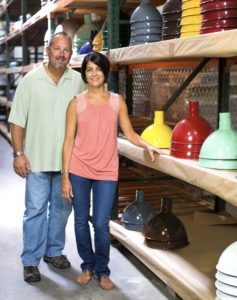Domestic lighting manufacturer Barn Light Electric (BLE), based in Titusville, Fla., is celebrating 10 years of success as one of the leading manufacturers of vintage-style lighting.
Owners Bryan and Donna Scott took a leap of faith when they left their professional careers to launch BLE as a full-time business in 2008. The company now occupies more than 65,000 square feet of office and manufacturing space, employs 130 people, and offers more than 5,000 products. BLE has also been featured on CNN, CNBC, and HGTV as a business success story.

“We didn’t know what would happen. We didn’t even know if we were going to be successful, but the business took off fast and furious,” Scott recalls. “Donna took a leave of absence from work intending to return but never did.”
Drawn to antique lights for their timeless designs and craftsmanship, the couple decided to manufacture their fixtures the old-fashioned way — by hand, using high-quality materials. They revived the art of metal spinning and introduced their own porcelain enamel operation in 2012. At the time, porcelain enamel lighting reportedly hadn’t been manufactured in the U.S. for more than 50 years.
An early hallmark of the industry, porcelain enamel was used as an extra layer of protection to keep these lights performing, even in industrial and agricultural settings. With the advent of cheaper materials and manufacturing techniques, most lighting fixtures lost this initial durability.
Motivated by a desire to return to the original way of doing things, Bryan and Donna focused on the manufacturing process for their lighting fixtures. Flat pieces of commercial-grade metal are spun on a lathe and are carefully manipulated and sculpted until they assume the proper shape. To fully replicate the quality found in vintage lights, a collection of these handcrafted shades are coated in porcelain.
“This meticulous process ingrains a tangible sense of dependability and integrity directly into each light we produce,” Bryan says. “My goal was to keep these fixtures American-made and employ people for the local economy. Although it was suggested we could make more money by shifting manufacturing overseas, that wasn’t going to happen. I wanted to give people an opportunity to work right here and be proud of something made in the U.S.”





